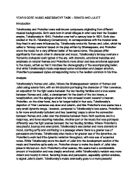YEAR 9 CORE MUSIC ASSESSMENT TASK – ROMEO AND JULIET
Introduction
Tchaikovsky and Prokofiev were well-known composers originating from different musical backgrounds. Both were born in small villages in what was then the Russian empire, Tchaikovsky in 1840, Prokofiev over half a century later in 1891. Both also studied at the St. Petersburg Conservatory. In correspondence with the musical eras they lived in and were influenced by, Tchaikovsky wrote his Romeo and Juliet, which he called a ‘fantasy overture’ based on the play written by Shakespeare, and Prokofiev wrote the music for a very different ballet of the same name. The pieces differ significantly from each other in character and mood, Tchaikovsky’s fantasy overture a Romantic orchestral work typical of the era, with dramatic, emotional melodies and emphasis on natural themes and Prokofiev’s more direct and less emotional approach to the music, written so that it matches the choreography of the accompanying ballet. And while Tchaikovsky’s music expressed some nationalism and deeper emotion, Prokofiev’s possessed styles corresponding more to the realism common in his time.
Analysis
Tchaikovsky’s Romeo and Juliet, follows the Shakespearean version of Romeo and Juliet using sonata form, with an introduction portraying the character of Friar Lawrence, an exposition for the fight scene between the two feuding families and a love scene between Romeo and Juliet, a development for the death of the two lovers, a recapitulation, and the epilogue where the ‘star-crossed lovers’ ascend to heaven. Prokofiev, on the other hand, had a far longer ballet in four acts. Tchaikovsky’s depiction of Friar Lawrence was slow and solemn, and like Prokofiev’s love scene has a very small dynamic range. However, compared to Tchaikovsky’s love scene, Prokofiev’s is far more emotionally turbulent and has ‘yearning’ steps to show the connection between Romeo and Juliet over the distance between them. Both sections are in a major key, and have recurring melodies. Another part or the music that was portrayed differently was the fight scenes between the two feuding families. Where Prokofiev’s was playful, bouncy and even jovial, Tchaikovsky’s was darker and more dramatic in mood, starting softly and continuing to a passage where there is a greater use of percussion and brass. Tchaikovsky also made a far greater use of the dynamics, as Prokofiev’s work had little dynamic variation throughout, with rare use of accented notes. While Tchaikovsky wrote the death of Juliet into the development section of his music and therefore quite early on, Prokofiev chose to make the death of Juliet take place in his last act. As in Prokofiev’s other scenes, this scene had a considerable amount of modulation and was deeply emotional, while Tchaikovsky’s version was more violent and mostly in minor, featuring brass and percussion, especially cymbal crashes, to signal Juliet’s death. Tchaikovsky’s music eventually goes to a more peaceful epilogue where the string passages resemble Prokofiev’s depictions of Juliet’s death, and a harp plays ascending arpeggios, giving a calming effect until a timpani roll and tonic chords played fortissimo by the orchestra end the piece.







